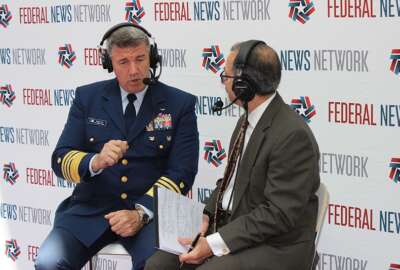
Coronavirus highlights Coast Guard’s issues with IT modernization
The Coast Guard says coronavirus is showing the cracks in the service's IT infrastructure.
The leader of the Coast Guard says the coronavirus outbreak is even more proof that the service needs a serious overhaul of its information technology infrastructure.
Coast Guard Commandant Adm. Karl Schultz said a few months ago that “years of investment tradeoffs have brought our information technology to the brink of catastrophic failure.” Now that more people are working at home, and will be for the foreseeable future due to COVID-19, Schultz says it’s time for the government to invest in the Coast Guard’s IT.
“I need to be fielding mobility for a bright, young workforce because they expect that; it’s a competitive disadvantage to not be doing that,” Schultz said Monday at the virtual Sea Air Space Conference. “I’ve got a situation where I have a workforce disaggregated all over the country to responsibly social distance, so that mobility is all the more important. I think the current crisis allows us to speak into that with some different efforts and urgency.”
Schultz said the Coast Guard has made some immediate expenditures on its IT systems to allow thousands of Coast Guard employees to keep working, and to keep tens of thousands of service members on the front lines connected.
“This crisis is showing how command, control, computers, communication, cyber and intelligence are to an organization like the Coast Guard,” Schultz said.
Part of the Coast Guard’s problem with modernizing IT is it hasn’t gotten the funding it needs to properly revolutionize its systems.
The service’s budgets have been mostly flat under the Trump administration. The 2021 request asks for $12.3 billion.
About $24 million of that would go into bettering IT infrastructure. However, the service is currently looking at a $300 million IT shortfall.
“There’s a money piece to this,” Schultz said. “We’ve got to stop patching old systems, stop layering in more complexity on old systems and really figure out what are those discreet initial steps we have to take. Then we can hopefully make a business case so people will support us in that annual budget process.”
Read more Defense news
Some of the updates the Coast Guard needs include increasing mobility to the workforce and moving to the cloud. Schultz said while the JEDI contract has its faults, the Coast Guard is looking into how it can leverage that cloud environment once it’s set up in the Defense Department. The commandant also said the service’s practices need to change.
“We need to refresh and recapitalize our technology on an industry-based standard, not the current standard,” Schultz said.
The Coast Guard’s tech issues have caused problems for the service’s ability to work.
Last summer, 95 vital systems went offline for several days due to a single server malfunction.
Over the next three years the Coast Guard is planning on increasing its internet speeds by 50% and doubling major cutter connectivity.
The service is also in the process of transitioning to Microsoft 365 to increase email reliability during day-to-day operations and critical crisis response efforts.
Copyright © 2025 Federal News Network. All rights reserved. This website is not intended for users located within the European Economic Area.
Scott Maucione is a defense reporter for Federal News Network and reports on human capital, workforce and the Defense Department at-large.
Follow @smaucioneWFED






